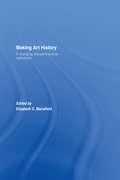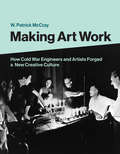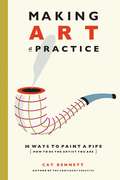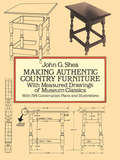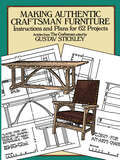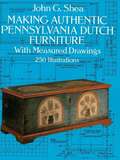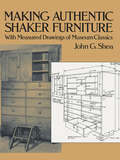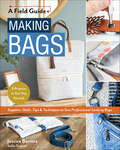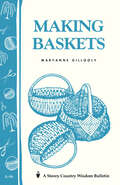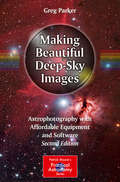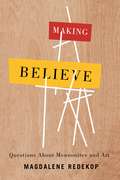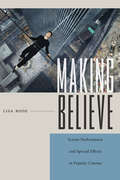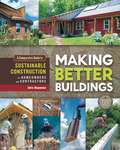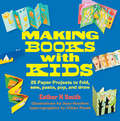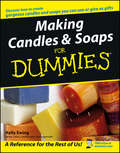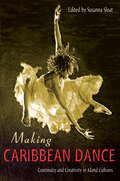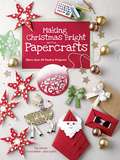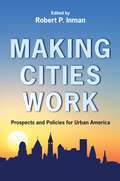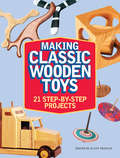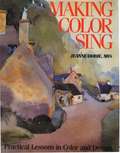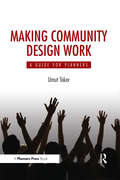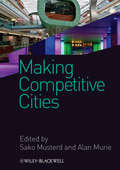- Table View
- List View
Making Art History: A Changing Discipline and its Institutions
by Elizabeth C. MansfieldMaking Art History is a collection of essays by contemporary scholars on the practice and theory of art history as it responds to institutions as diverse as art galleries and museums, publishing houses and universities, school boards and professional organizations, political parties and multinational corporations. The text is split into four thematic sections, each of which begins with a short introduction from the editor, the sections include: Border Patrols, addresses the artistic canon and its relationship to the ongoing 'war on terror', globalization, and the rise of the Belgian nationalist party. The Subjects of Art History, questions whether 'art' and 'history' are really what the discipline seeks to understand. Instituting Art History, concerns art history and its relation to the university and raises questions about the mission, habits, ethics and limits of university today. Old Master, New Institutions, shows how art history and the museum respond to nationalism, corporate management models and the 'culture wars'.
Making Art Panamerican: Cultural Policy and the Cold War
by Claire F. FoxAmong the buildings on the National Mall in Washington, D.C., only the Pan American Union (PAU) houses an international organization. The first of many anticipated &“peace palaces&”constructed in the early twentieth century, the PAU began with a mission of cultural diplomacy, and after World War II its Visual Arts Section became a leader in the burgeoning hemispheric arts scene, proclaiming Latin America&’s entrée into the international community as it forged connections between a growing base of middle-class art consumers on one hand and concepts of supranational citizenship and political and economic liberalism on the other.Making Art Panamerican situates the ambitious visual arts programs of the PAU within the broader context of hemispheric cultural relations during the cold war. Focusing on the institutional interactions among aesthetic movements, cultural policy, and viewing publics, Claire F. Fox contends that in the postwar years, the PAU Visual Arts Section emerged as a major transfer point of hemispheric American modernist movements and played an important role in the consolidation of Latin American art as a continental object of study. As it traces the careers of individual cultural policymakers and artists who intersected with the PAU in the two postwar decades—such as Concha Romero James, Charles Seeger, José Gómez Sicre, José Luis Cuevas, and Rafael Squirru—the book also charts the trajectories and displacements of sectors of the U.S. and Latin American intellectual left during a tumultuous interval that spans the Mexican Revolution, the Spanish Civil War, the New Deal, and the early cold war. Challenging the U.S. bias of conventional narratives about Panamericanism and the postwar shift in critical values from realism to abstraction, Making Art Panamerican illuminates the institutional dynamics that helped shape aesthetic movements in the critical decades following World War II.
Making Art Work: How Cold War Engineers and Artists Forged a New Creative Culture
by W. Patrick MccrayThe creative collaborations of engineers, artists, scientists, and curators over the past fifty years.Artwork as opposed to experiment? Engineer versus artist? We often see two different cultural realms separated by impervious walls. But some fifty years ago, the borders between technology and art began to be breached. In this book, W. Patrick McCray shows how in this era, artists eagerly collaborated with engineers and scientists to explore new technologies and create visually and sonically compelling multimedia works. This art emerged from corporate laboratories, artists' studios, publishing houses, art galleries, and university campuses. Many of the biggest stars of the art world--Robert Rauschenberg, Yvonne Rainer, Andy Warhol, Carolee Schneemann, and John Cage--participated, but the technologists who contributed essential expertise and aesthetic input often went unrecognized.
Making Art a Practice
by Cat BennettHelping artists catapult into further action, this guide is a treasury of insight and inspiration. Rather than focus on art techniques that build skills or overcome creative blocks through playful activities or writing, this guide walks the artist through exercises designed to develop the personal qualities critical to being an artist in the world, such as courage, the ability to look and see, and connection to the true creative self. This is a hands-on, experiential action book designed to get the reader creating art and exploring a variety of possibilities for being an artist. According to the teachings of this handbook, engagement with art is less about end results or products and more about the self-awareness and competence that frees the artist to seek out and create work that is vital. This is a rigorous programme that allows artists of any skill level to deepen their creative habits and be the best artists possible.
Making Authentic Country Furniture: With Measured Drawings of Museum Classics
by John G. SheaThis outstanding work provides furniture makers and woodworkers with the principal antique country furniture designs used in North America during the past 400 years. Concerned only with provincial handmade designs — generally of simple solid-wood construction — John Shea's carefully researched and abundantly illustrated volume includes 95 measured drawings from which serious students and craftworkers can reproduce their own versions of these antique classics. All important European influences are represented — English, Irish, Scottish, Welsh, French, Dutch, German, Spanish, and Norwegian among them.Among the pieces represented are Shaker chairs, rockers, tables, and a wall cupboard; a New England settle, Spanish trestle table, Dutch gateleg table, French Canadian armoire and dresser, a Pennsylvania German corner cupboard and plate rack, as well as a wide array of country bedsteads, benches, stools, candlestands, plate racks, wall sconces, and much more.Additional sections of the book provide historical background to several regional designs, describing the effects that various nationalities and ethnic and religious roots have had on furniture design and construction. A number of construction techniques (for creating dovetail joints, applied moldings, scrolled paneling, cabriole legs, mortise-and-tenon joints, and more) are also explored.Profusely illustrated with some 800 photographs and line drawings, this richly informative manual will be valued by furniture makers for its clearly delineated technical segments as well as by anyone who has ever been fascinated by the construction and design of antique furniture.
Making Authentic Craftsman Furniture: Instructions and Plans for 62 Projects
by Gustav StickleyMake authentic reproductions of handsome, functional, durable furniture: tables, chairs, wall cabinets, desks, a hall tree, and more. Construction plans with drawings, schematics, dimensions, and lumber specs reprinted from 1900s The Craftsman magazine.
Making Authentic Pennsylvania Dutch Furniture: With Measured Drawings
by John G. SheaRichly illustrated guide to the design, construction, painting, and decoration of a host of distinctive pieces -- candle stands to four-posters. Includes designs for 24 popular hex signs and measured drawings for building 50 representative pieces: chairs, tables, desks, and many more. 250 illustrations. Bibliography.
Making Authentic Shaker Furniture: With Measured Drawings of Museum Classics
by John G. SheaThis splendid book describes and illustrates in detail how the Shakers designed, built, and finished their furniture and household articles. With its detailed text as well as over 250 photographs and measured drawings for over 80 classic pieces, it offers woodworkers and furniture enthusiasts a practical guide to the essentials of replicating a broad range of designs long admired for their sturdy practicality and their spare, elegant beauty.The book first chronicles and describes the Shaker movement and the Shaker way of living, worshiping, and working. It then explores the Shaker approach to furniture design (from chests and chairs to boxes and baskets), construction (including all joinery techniques), and finishing (including recipes for finishes).Three important sections of the book depict dozens of classic Shaker designs, complete with measured drawings. The designs include Shaker "smallcraft" such as a cutting board, scoop, candle sconce, peg-leg footstool and towel rack; more substantial "utility designs" such as a dough bin, cradle, dry sink, butcher block, and bonnet box; and furniture classics such as a Harvard trestle table, maple chair, lap desk, sewing chest, rocking chair, bed, settee and chest of drawers -- each in its own distinctive way defining the simple, practical grace of Shaker design.
Making Bags, A Field Guide: Supplies, Skills, Tips & Techniques to Sew Professional-Looking Bags; 5 Projects to Get You Started (A\field Guide Ser.)
by Jessica Sallie BarreraA complete guide to bag-making Couture bags without the couture price? Yes, please. Whether you are beginning or looking to expand your bag-making, you can create professional-looking bags to fit your style and practical needs with Making Bags. Bags are infinitely customizable projects -- there are so many fabrics, hardware, and zippers to explore. This valuable resource has all the information and techniques needed to work with diverse materials and achieve endless style combinations. Trendy baguette bags, duffle bags, saddle bags, and so many more styles are covered in this book. Make five bag projects to practice your new skills and apply basic to advanced sewing techniques Jessica Barrera, the owner of Sallie Tomato, gives you the full scoop on fabrics from standard quilting cotton to specialty materials like cork, velvet, vinyl, kraft-tex (vegan leather), and so much more Follow along all the steps of the bag-making process with this visual guide
Making Baskets: Storey's Country Wisdom Bulletin A-96 (Storey Country Wisdom Bulletin Ser.)
by Maryanne GilloolySince 1973, Storey's Country Wisdom Bulletins have offered practical, hands-on instructions designed to help readers master dozens of country living skills quickly and easily. There are now more than 170 titles in this series, and their remarkable popularity reflects the common desire of country and city dwellers alike to cultivate personal independence in everyday life.
Making Beautiful Deep-Sky Images
by Greg ParkerThis book is based around the author's beautiful and sometimes awe-inspiring color images and mosaics of deep-sky objects. The book describes how similar "Hubble class" images can be created by amateur astronomers in their back garden using commercially available telescopes and CCD cameras. Subsequent processing and image enhancement in the "electronic darkroom" is covered in detail as well. A range of telescopes and equipment is considered, from the author's 11-inch with Hyperstar camera, down to more affordable instruments. Appendices provide links to free software - not available from a single source - and are themselves an invaluable resource.
Making Believe: Questions About Mennonites and Art
by Magdalene RedekopMaking Believe responds to a remarkable flowering of art by Mennonites in Canada. After the publication of his first novel in 1962, Rudy Wiebe was the only identifiable Mennonite literary writer in the country. Beginning in the 1970s, the numbers grew rapidly and now include writers Patrick Friesen, Sandra Birdsell, Di Brandt, Sarah Klassen, Armin Wiebe, David Bergen, Miriam Toews, Carrie Snyder, Casey Plett, and many more. A similar renaissance is evident in the visual arts (including artists Gathie Falk, Wanda Koop, and Aganetha Dyck) and in music (including composers Randolph Peters, Carol Ann Weaver, and Stephanie Martin). Confronted with an embarrassment of riches that resist survey, Magdalene Redekop opts for the use of case studies to raise questions about Mennonites and art. Part criticism, part memoir, Making Believe argues that there is no such thing as Mennonite art. At the same time, her close engagement with individual works of art paradoxically leads Redekop to identify a Mennonite sensibility at play in the space where artists from many cultures interact. Constant questioning and commitment to community are part of the Mennonite dissenting tradition. Although these values come up against the legacy of radical Anabaptist hostility to art, Redekop argues that the Early Modern roots of a contemporary crisis of representation are shared by all artists. Making Believe posits a Spielraum or play space in which all artists are dissembling tricksters, but differences in how we play are inflected by where we come from. The close readings in this book insist on respect for difference at the same time as they invite readers to find common ground while making believe across cultures.
Making Believe: Screen Performance and Special Effects in Popular Cinema
by Lisa BodeIn the past twenty years, we have seen the rise of digital effects cinema in which the human performer is entangled with animation, collaged with other performers, or inserted into perilous or fantastic situations and scenery. Making Believe sheds new light on these developments by historicizing screen performance within the context of visual and special effects cinema and technological change in Hollywood filmmaking, through the silent, early sound, and current digital eras. Making Believe incorporates North American film reviews and editorials, actor and crew interviews, trade and fan magazine commentary, actor training manuals, and film production publicity materials to discuss the shifts in screen acting practice and philosophy around transfiguring makeup, doubles, motion capture, and acting to absent places or characters. Along the way it considers how performers and visual and special effects crew work together, and struggle with the industry, critics, and each other to define the aesthetic value of their work, in an industrial system of technological reproduction. Bode opens our eyes to the performing illusions we love and the tensions we experience in wanting to believe in spite of our knowledge that it is all make believe in the end.
Making Better Buildings
by Chris Magwood Jen FeiginMuch has been written about the individual components of sustainable building, but how do you bring it all together into a well-designed whole? Drawing on extensive hands-on experience, Making Better Buildings systematically describes the real-world implications of the most popular green and natural building materials and techniques, objectively presenting the pros, cons and overall viability of each. An indispensable resource.
Making Birdhouses: Easy and Advanced Projects
by Leon H. Baxter Gladstone CaliffThis practical guide for building birdhouses contains plans for more than fifty attractive and useful structures — from a one-room house for bluebirds to a forty-two-room structure for purple martins. In addition to instructions and diagrams for constructing houses for such avian varieties as robins, wrens and chickadees, the easy-to-follow text also provides suggestions for feeding devices, bird house materials, methods of finishing exteriors, and winter care for birds. An authoritative, how-to book that will appeal to beginning and veteran woodcrafters alike, Making Birdhouses also features a supplement with easy projects for novices — among them simple structures for woodpeckers, a box for robins, and an “A-frame” for nuthatches. Plans for houses made from such common objects as gourds, a flower pot, tin cans, and an old lantern are also included.Detailed instructions and diagrams assure successful completion of projects that will satisfy builders as well as their feathered friends.
Making Books with Kids: 25 Paper Projects to Fold, Sew, Paste, Pop, and Draw (Hands-on Family Ser.)
by Esther K. SmithThis illustrated guide features twenty-five projects to share with crafty kids who love to read—with simple techniques for book binding, pop-up books and more!In Making Books with Kids, master book artist Esther K.¬†Smith shares kid-friendly, easy-to-follow instructions for a variety of fun and creative bookmaking projects—all supported with step-by-step, full-color photographs and illustrations. Each sequence is accompanied by finished samples and variations as well as Smith's own inspiring work.Full of paper crafting techniques, including sewing, collage, pop-up assemblage and more, the lessons in this book are both practical and open-ended, offering plenty of room for exploration and variation. Colorful photos illustrate how different people using the same lesson will yield different results, exemplifying the way the lesson brings out each artist's personal style. Children of all ages and experience levels can be guided by adults and will enjoy these engaging exercises.
Making Candles and Soaps For Dummies
by Kelly EwingMake floating candles, herbal soaps, and even a home spa Discover the secrets of color, shape, and scent the fun and easy way? Whether you're a beginner or seasoned craftperson, this fun book offers everything you need to make beautiful, professional-looking candles and soaps at home. You get practical tips on dyeing and scenting wax, using unusual molds, adding embellishments to candles, working with soap ingredients, and even turning your hobby into a business! Discover How To: Stock a safe & efficient work area Work with all types of wax Add color and scent to your projects Make melt-and-pour soaps Turn a hobby into a business
Making Caribbean Dance: Continuity and Creativity in Island Cultures
by Susanna SloatExplore the vibrant and varied dance traditions of the Caribbean islandsCaribbean dance is a broad category that can include everything from nightclubs to sacred ritual. Making Caribbean Dance connects the dance of the islands with their rich multicultural histories and complex identities. Delving deep into the many forms of ritual, social, carnival, staged, experimental, and performance dance, the book explores some of the most mysterious and beloved, as well as rare and little-known, dance traditions of the region.From the evolution of Indian dance in Trinidad to the barely known rituals of los misterios in the Dominican Republic, this volume looks closely at the vibrant and varied movement vocabulary of the islands. With distinctive and highly illuminating chapters on such topics as experimental dance makers in Puerto Rico, the government's use of dance in shaping national identity in Barbados, the role of calypso and soca in linking Anglophone islands, and the invented dances of dance-hall kings and queens of Jamaica, this volume is an evocative and enlightening exploration of some of the world’s most dynamic dance cultures.
Making Christmas Bright with Papercrafts: More Than 40 Festive Projects!
by Alice Hornecke Dominik Meißner Sabine SeyffertChristmas is an ideal time to get in the spirit of the season by creating festive decorations and gifts with a personal touch. This delightful collection of 43 unique papercraft projects will get everyone in a festive mood with its decorative suggestions for the home and the holiday table, Christmas tree ornaments, handmade gifts, and much more. The book abounds in photos, templates, and easy-to-follow instructions for everything from a beautiful origami wreath to cut-out snowflakes, place-setting accessories, gift-wrapping accents, and an Advent candle holder. Each project is accompanied by helpful tips as well as a list of materials and measurements. The splendid variety of options make this the perfect guide and resource for papercrafters at every level of experience.
Making Cinelandia: American Films and Mexican Film Culture before the Golden Age
by Laura Isabel SernaIn the 1920s, as American films came to dominate Mexico's cinemas, many of its cultural and political elites feared that this "Yanqui invasion" would turn Mexico into a cultural vassal of the United States. In Making Cinelandia, Laura Isabel Serna contends that Hollywood films were not simply tools of cultural imperialism. Instead, they offered Mexicans on both sides of the border an imaginative and crucial means of participating in global modernity, even as these films and their producers and distributors frequently displayed anti-Mexican bias. Before the Golden Age of Mexican cinema, Mexican audiences used their encounters with American films to construct a national film culture. Drawing on extensive archival research, Serna explores the popular experience of cinemagoing from the perspective of exhibitors, cinema workers, journalists, censors, and fans, showing how Mexican audiences actively engaged with American films to identify more deeply with Mexico.
Making Cities Work: Prospects and Policies for Urban America
by Robert P. InmanMaking Cities Work brings together leading writers and scholars on urban America to offer critical perspectives on how to sustain prosperous, livable cities in today's fast-evolving economy. Successful cities provide jobs, quality schools, safe and clean neighborhoods, effective transportation, and welcoming spaces for all residents. But cities must be managed well if they are to remain attractive places to work, relax, and raise a family; otherwise residents, firms, and workers will leave and the social and economic advantages of city living will be lost. Drawing on cutting-edge research in the social sciences, the contributors explore optimal ways to manage the modern city and propose solutions to today's most pressing urban problems. Topics include the urban economy, transportation, housing and open space, immigration, race, the impacts of poverty on children, education, crime, and financing and managing services. The contributors show how to make cities work for diverse urban constituencies, and why we still need cities despite the many challenges they pose. Making Cities Work brings the latest findings in urban economics to policymakers, researchers, and students, as well as anyone interested in urban affairs. In addition to the editor, the contributors are David Card, Philip J. Cook, Janet Currie, Edward L. Glaeser, Joseph Gyourko, Richard J. Murnane, Witold Rybczynski, Kenneth A. Small, and Jacob L. Vigdor.
Making Classic Wooden Toys: 21 Step-by-Step Projects
by Scott FrancisMake toys that will be treasured for generations! Wooden toys stand the test of time. They're played with, love and often go on to become treasured family heirlooms. Plus making toys is a great way to put to good use all those small offcuts of nicer wood you've been saving.Making Classic Wooden Toys is filled with 21 projects selected from the archives of Popular Woodworking Magazine and American Woodworker. The toys inside hark back to a time of childhood wonder and fun. From tricky puzzles and clever gizmos to sports equipment and kid's furniture, you'll learn to make a wide array of gifts that any child is sure to love. Within these pages you'll find step-by-step instructions along with helpful photos and illustrations for:A variety of wooden puzzlesTabletop versions of games including hockey and foosballFun furniture including a play table, a game table and a tractor-trailer toyboxPopular lawn games including bocce and kubbSpinning tops, whistles and other classic toysWhat better way to show your love for a child than with a handmade wooden toy that will be passed on for generations to come?
Making Color Sing
by Jeanne Dobie<P>In this innovative book, author and crafter Carolyn Dahl demonstrates how printing with a natural material--covering it with a medium and pressing it to a surface--allows artists to see and appreciate exquisite, often-overlooked details and make physical contact with the earth that sustains us. Natural Impressions begins with practical guidance on collecting materials and objects, along with basic instructions for making a successful nature print. <P> Divided into three sections--leaves, flowers, and fish--the book clearly demonstrates a variety of techniques using an array of mediums; for example, paints/pigments, bleach, collage, markers, textile paints, and even rubber stamps. Plus, a special section details how nature prints can meet today's technology with photocopying and computer manipulation.
Making Community Design Work: A Guide For Planners
by Umut TokerSince the earliest settlements, people have deliberated the issues that affect their future together. Making Community Design Work shows how planners can guide the process toward effective decision making and beneficial community design. This well-crafted book distills decades of community design experience into a sound conceptual framework of value to practicing planners as well as planning students. Umut Toker covers a broad range of planning scales and introduces field-tested tools for participatory decision making at regional, city, community, and site-specific levels. To succeed, any planning project must address both the physical space and its users. From setting goals to evaluating results, Making Community Design Work helps planners navigate the process of creating environments that meet the needs of the people they serve.
Making Competitive Cities
by Sako Musterd Alan MurieThe book investigates the impact on the competitiveness of cities developing creative industries (arts, media, entertainment, creative business services, architects, publishers, designers) and knowledge-intensive industries (ICT, R&D, finance, law). It provides significant new knowledge to the theoretical and practical understanding of the conditions necessary to stimulate "creative knowledge" cities.The editors compare the socio-economic developments, experiences and strategies in 13 urban regions across Europe: Amsterdam, Barcelona, Birmingham, Budapest, Dublin, Helsinki, Leipzig, Milan, Munich, Poznan, Riga, Sofia and Toulouse. These have different histories and roles; include capital and non-capital cities of different sizes; represent cities with different economic structures; and different cultural, political and welfare state traditions.Through this wide set of examples, Making Competitive Cities informs the debate about creative and knowledge-intensive industries, economic development, and competitiveness policies. It focuses on which metropolitan regions have a better chance to develop as "creative knowledge regions" and which do not, as well as investigating why this is so and what can policy do to influence change.Chapter authors from thirteen European institutions rigorously evaluate, reformulate and empirically test assumptions about cities and their potential for attracting creative and knowledge-intensive industries. As well as a systematic empirical comparison of developments related to these industries, the book examines the pathways that cities have followed and surveys both the negative and positive impacts of different prevailing conditions.Special Features:Analyses link between knowledge-intensive sectors and urban competitivenessOffers evidence from 13 European urban regions drawn from a major research projectEstablishes a new benchmark for academic and policy debates in a fast-moving field
